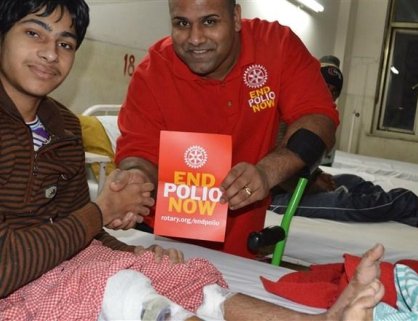
WHO South-East Asia Region was certified polio-free, proving wrong many public health experts who believed that the Region, which accounts for one-fourth of the global population, would be the last bastion for polio eradication. Five years on, the Region not only continues to maintain its polio-free status but is demonstrating how the polio legacy can effectively strengthen overall immunization and other programs.
“Member countries, partners and the community themselves continue to work together to keep the crippling virus at bay. The polio program’s emphasis on innovation and reaching everyone, everywhere is being replicated by many other public health programs with impressive results,” said Dr Poonam Khetrapal Singh, Regional Director, WHO South-East Asia Region.
The last case of wild poliovirus in the Region was reported from West Bengal, India, where a two-year old girl suffered polio paralysis on 13 January 2011. An intense response by Government of India supported by WHO, UNICEF, Rotary International and other partners ensured it remained the last case in WHO South-East Asia Region.
Post certification, these efforts continue. Every year, more than 32 million children across the Region are being reached with oral polio vaccines under routine immunization and through mass polio vaccination campaigns to maintain high population immunity against polio. In India, an additional 460 million doses of oral polio vaccines were given to children through four mass polio vaccination campaigns conducted in 2018.
As a part of the vigilance for polio in the Region, surveillance for polio continues to be further strengthened. More than 75 000 stool samples were tested in 16 poliovirus laboratories in the Region in 2018. Environmental surveillance for poliovirus detection has been expanded three-fold in the last five years. Samples are now collected for testing from 74 sites in India, Indonesia, Bangladesh, Nepal, Myanmar and Thailand. In 2014, environment surveillance was conducted only in India, from 23 sites.
While continuing to maintain a strict vigil against polio, the entire polio machinery in the Region is also geared towards strengthening routine immunization to further boost defense against polio as well as other vaccine preventable diseases. There has been a steady progress in immunization coverage of the basic vaccines provided in the first year of life. Nearly 88% children in the Region are receiving three doses of the basic vaccines before they achieve the age of one year. In seven of the 11 countries, this coverage is over 90%. All countries have introduced at least two new vaccines under their routine immunization program to protect children from vaccine preventable diseases.
Polio program and its lessons are guiding efforts to eliminate measles and control rubella, a flagship priority program in WHO South-East Asia Region.
The polio networks are also supporting countries to strengthen vaccine preventable disease surveillance.
“This day is a reminder of our momentous victory against polio, a reminder of our commitment to health of our children, and a reminder of our potential, of our determination to turn impossible into possible,” the Regional Director said.
- Japanese Ambassador Kikuta And DPM Shrestha Shared The Views to Deepen Nepal-Japan Bilateral Relations
- Apr 19, 2024
- India Provides Financial Support To Build A School Building In Darchula
- Apr 19, 2024
- Shalom Club-Nepal Expresses Solidarity With Israel Against Iran-attack
- Apr 19, 2024
- Foreign Secretary Lamsal Urged Bangladeshi To Explore Investment Opportunities In Nepal
- Apr 19, 2024
- Nepal Should Get Compensation For Damaged Caused By Climate Change: Minister Pun
- Apr 19, 2024
















